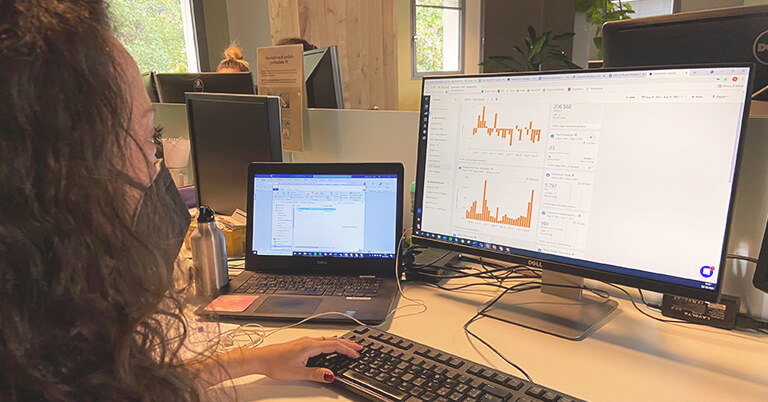How is a brand perceived by people on social media? This is a question that sooner or later every company asks itself. The first road we take in TSW is always to address to people: there are different methods to investigate brand perception, such as the one we used for Woolrich, and that we have described in this article.
On social media, however, there are specific dynamics, and sometimes listening to what people tell us when they answer direct questions can only give us a partial view. For that reason, we combine this method with social listening, that is, listening to the conversations that take place on social media around our brand, whether we are the ones that started them or not. Ignoring them won’t make them go away and will make us blind to a series of facts, because we will have an incomplete picture of the real digital perception of a brand.
Integrating social media listening into your digital strategies is essential to create truly relevant experiences for people, that originate from their needs, whether expressed directly or indirectly.

The differences between social media listening and monitoring
For many, “social media listening and monitoring” are synonymous and, it is true that they belong to the family tree of listening strategies, but they are not equivalent.
Social media listening intercepts the conversations that take place within social media, also going beyond the perimeter of these, to offer us a general picture of the brand perception by embracing the more general web listening, with the aim of bringing out valuable insights on:
- business strategy
- tone of voice
- which people to involve
- sentiment, the main insight of the strategy
Social media monitoring, on the other hand, is an operational activity of monitoring conversations on social media that takes place over a defined period of time, with a beginning and an end, a continuous process that allows us to validate our daily community management activities.
The real difference is in the attitude: social media listening is proactive, while social media monitoring is reactive. So, from a strategic perspective, we at TSW, prefer as always proactive listening. However, this doesn’t mean that we don’t benefit from the use of monitoring, integrating it with listening, especially for those clients who have entrusted us with the dialogue with customers on their social media pages.
The best free and paid social media listening tools
We have seen what social listening is, but how to put it into practice? The easiest way is, undoubtedly, to opt for the tools on the web, social listening software that poll the social media and the network, looking for keywords that we are interested in monitoring.
What the social listening tool returns to us is a zero-time display of:
- Brand mentions in a specific country or market
- Recurring sources
- Comments categorized as positive, neutral, negative
The web is teeming with social listening tools, here are a few which we think are good:
- For a fee: the most famous is undoubtedly Talkwalker, followed closely by Digimind and SocialBakers;
- Free: the search for free social listening tools is more complex because we tend to talk about paid tools, which offer a free version with a very limited application. However, we would like to mention Google Alerts, which intercepts mentions of specific keywords in the Google network by sending an email notification.
The limits of social media listening: how to overcome them by listening to people
Not even with paid tools can we access all conversations on social networks: we only have free access on Twitter and LinkedIn, while Instagram and Facebook close their doors with increasingly stringent privacy. Yet, it is precisely in these two social networks that the volume of conversations reaches its highest peaks.
How to fill this gap? It remains opened the possibility of overcoming the limitations of the tools by operating manually, like the old guard. The time we spend on the network will be rewarded by:
- an increase in our reading ability
- a greater sensitivity to the data that machine will never have
- clear and content-rich insights mined directly by us
Social media listening: a case study example of success
Now we get to how we kick social media listening to the curb in TSW, thanks to a social listening case study.
A well-known company in the automotive sector asked us to carry out an in-depth social media listening activity, in order to understand the level of appreciation of a new motorcycle model and to detect any gaps in the communication strategy: we followed up this request with a meticulous analysis on Instagram and Facebook channels.

What made the company want to do this activity? The difference between the vehicle’s significant sales records and the low ratings on social.
After an intense activity of interception, categorization and filtering of about 25,000 comments, it turned out that what was driving the social conversations towards a negative perception was a real perceptual shock, due to the revolutionary change of the vehicle’s engine: the first of the brand to mount it, and precisely for this reason also the focus of the communication campaign. This drastic change convinced people online to talk in a certain way about a vehicle even before trying it out. Once the bike is purchased, however, it becomes a success.
What did the company take home from this activity? People, at the time of launch, were not ready to accept the change on a perceptual level, even if this did not affect the actual sales of the product.
This evidence guided the marketing and communication strategy for the launch of the next motorcycle model: the innovative engine, although present, it was not the main message, concentrated on other key features of the vehicle: this choice was a success both in terms of online perception and sales.
This example demonstrates how a seamless integration of manual and tool-based listening makes social media listening an effective tactic to consider in your digital strategies.
Best practices and tips
What have we learned and continue to learn from our daily use of social media listening? Here are our 5+1 social listening best practices from the field that can help you find your way around social listening:
#1 What, When, Why: The Core of the Organization
Getting lost in the maze of social conversations is a real risk, so organization is everything:
- What’s your goal?
- What do you really want to look for?
- What’s the time horizon you’ve given yourself?
These are all questions you can’t avoid asking yourself when you need to start a social listening activity.
#2 Where: Identify sources of data
This is a particularly important W, which allows you to limit your search to only those channels that are really interesting for your purposes.
#3 Don’t start until you know how to measure
The golden rule for any marketing strategy, which therefore also applies to social media listening: choose metrics (also called KPIs) right from the start, will then help you to do analysis. Here are some examples:
- sentiment
- popularity
- more engaging topics
#4 Stay Focused
As you’re analyzing and organizing material you might catch some conversations that require your intervention. If your company also implements social media monitoring pass the ball along, if not… it could be a sign that it’s time to implement it!
#5 Open your mind and listen to what you don’t hear
Don’t forget that, as with in-person listening, the most valuable insights lurk between the lines when you’re not looking for them. That’s where some insights about topics or brand characteristics that you weren’t expecting might emerge. In this case, don’t go on autopilot, but put it in neutral and think: could it be time to take a detour?
#6 Final Reminder: Listening is different from hearing
A mantra to carry with you throughout the duration (and even after!) social listening: let’s talk about Listening, with a capital L. A comment or a review has value for what it says on a formal-structural level, but much more for what it conceals, like: people’s fears, emotions, desires and needs. These are the real topics to listen to.